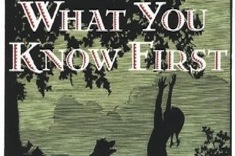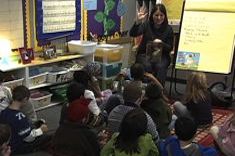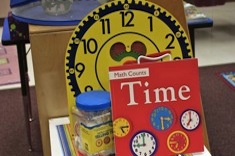Last summer, Kim moved from Long Island to Wellington, Florida. Although the move was an exciting and celebrated adventure for her family, leaving her dear home where both of her sons had spent their young boyhood was difficult. She decided to walk through the house with her family and reminisce in each room. Room by room they talked about their most prominent memories in each one: watching snowfall from the window seat in the family room, marking Matthew and Nathan’s heights on the wall below the stairs in the basement, and the time Nathan took pancake mix from the pantry to cook up pancakes of his own in his play kitchen.
As this school year winds down, it is likely that the promise of restful summer days makes the matriculation of your class considerably less emotional than leaving your longtime home, but the transition may still bring with it emotions—for you and for your students. You can sort through the range of emotions by exploring books that tell stories of characters who are preserving or documenting memories. We have four favorite titles for reminiscing about a school year and marking the passage of time.
Wilfrid Gordon McDonald Partridge written by Mem Fox and illustrated by Julie Vivas
In this classic story, Wilfrid, who lives next door to an “old folks home,” gathers objects to help his best friend—Miss Nancy Allison Delacourte Cooper—reclaim her memory. Each object Miss Nancy pulls from Wilfrid’s basket of special reminders triggers her memory of an event in her life and ultimately helps her regain her memory. To use this story to remember the school year, fill a basket of tangible reminders of events of the year: a plastic whale as a memento of a field trip to the aquarium, a seed as a reminder of plants grown in a science unit, a book of poetry as a reminder of all the poetry written through the year. Pull each item out of the basket and ask the children to share the memories it triggers, or let students select an item and write about their memories associated with it.
I Know Here written by Laurel Croza and illustrated by Matt James
This beautifully illustrated story chronicles the author’s childhood move from northeastern Saskatchewan to Toronto. Croza beautifully communicates the angst and anticipation of leaving the “here” she knows. Our favorite part of the story is when the author describes each place she knows: the frogs in the lake, the howl of the wolves, the road she walks to school every day. At her teacher’s request, she draws each part of her “here” so that she can take it with her. In celebration of the school year, read I Know Here and help students think about the dimensions of your classroom community that they want to take with them. Give them time to write and illustrate what they “know” about being a part of this year’s class.
What You Know First written by Patricia MacLachlan and illustrated by Barry Moser
What You Know First tells the story of a child who resists the idea of moving away from her childhood farm on the prairie. She is sad about leaving behind the things that she loves most, such as the cottonwood tree in her backyard and the geese who “sky-talk in the spring.” The impending change overwhelms her. By the end of the story, she reconciles these emotions when she realizes that collecting a bag of prairie dirt or packing a twig from the cottonwood tree can help her remember and honor the place and memories that are dearest to her. Give students an opportunity to hold space for whatever emotions they are experiencing by encouraging them to think about ways to remember and honor the school year. Take a walk around the school to notice the sights, sounds, and smells they want to “try hard to remember.” When possible, allow students to collect small tokens—such as an old cray-pas from the art room or a rock from the playground—to serve as reminders of their year.
The Memory Box written by Mary Kay Shanley and illustrated by Ted Rand
This is the story of multiple generations who realize the same thing: that memories are in the heart of the keeper. As a middle-aged woman helps her aging mother pack up her childhood home, they each come across special boxes filled with mementos. The middle-aged woman casts her box aside, whereas her aging mother takes care to ensure that her box arrives safely in her new home. In time, they each share the contents with their daughter/granddaughter, who relishes the stories evoked by the artifacts in the boxes and becomes inspired to create a memory box of her own. As you begin to dismantle your classroom, treat the items you put away like mementos going into a memory box. Before you shove books into a box to store on a shelf over the summer, share memories of reading aloud. As you pack away the anchor charts hanging up around the classroom, talk about the different students who contributed ideas to their development or let children share their memories of how the charts evolved. You may even invite students to decorate a shoe box and help them collect artifacts to remind them of their best memories from this school year.
Although there may be some truth to the popular narrative about children being “happy” about the end of the school year, for many children, there is another, equally true but less talked about counter-narrative about change, growth, and even loss. Reading aloud gives students a mirror for looking at these sorts of paradoxes, which can help them to understand their conflicting emotions as well as bring the year to a satisfying end.






